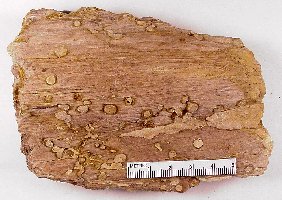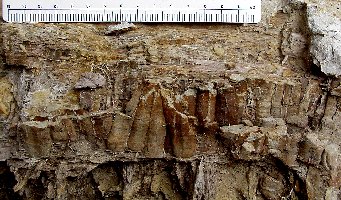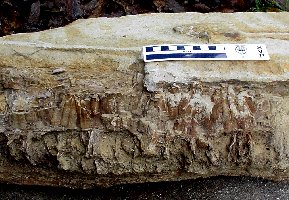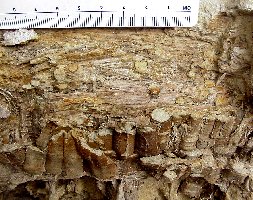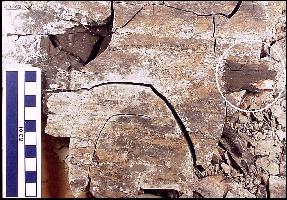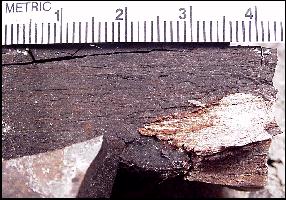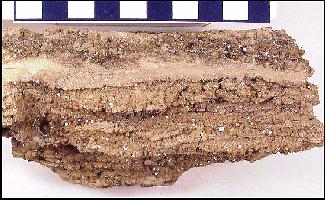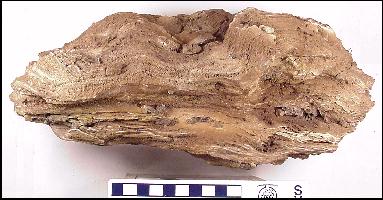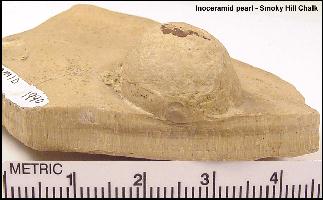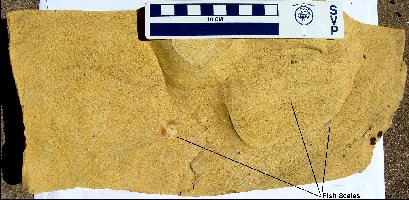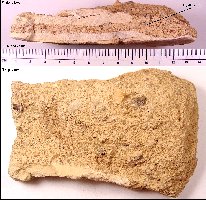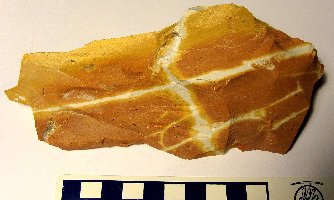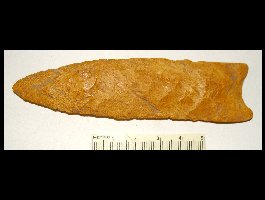 |
A Field Guide to Fossils of the Smoky
Hill Chalk
Part 5: Coprolites, pearls, fossilized wood and
other remains.
Copyright © 2004-2012 by Mike Everhart
Page created 08/12/2004; Last Updated
09/09/2012
LEFT: Several views of a giant fossil
pearl found in the Smoky Hill Chalk, Gove County, Kansas (Click
to enlarge). The specimen is the size of half a golf ball. |
Continued from Part 4; Pteranodons,
Birds and Dinosaurs
F. OTHER KINDS OF SMOKY HILL CHALK FOSSILS:
1. Coprolites: The remains of feces / excreta are often found in the
chalk and sometimes contain well preserved vertebra and other fish bones. They are white
and chalky in appearance, and since they are composed largely of calcium phosphate, they
are more resistant to erosion than is the surrounding chalk. For more information, see my Coprolite webpage.
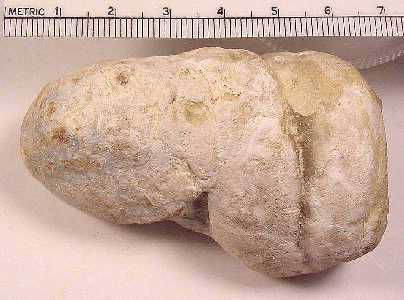 |
LEFT: A large shark or mosasaur coprolite found in the lower Smoky
Hill Chalk. The mass includes small pieces of bone and fish scales. RIGHT:
Shell coprolites - Small, compacted masses of oyster shell
fragments are found only in a limited zone in the lower 1/3 of the chalk. These appear to
be the coprolites from a fish or other predator that fed exclusively on oysters. At this
point, only the plethodid Martinichthys is a candidate. |
 |
2. Fossilized Wood - Pieces of logs and branches floated out into the Western
Interior Sea where they became water logged and sank to the bottom.
Professor B. F. Mudge (1877, p. 283-284) was among the
first to note the presence of “an occasional fragment of fossilized wood.
… This wood was, in a few instances, bored before fossilization by some small animal.
This might have been done by the larva of an insect (a “borer”) when the tree
was living, or later by a teredo when the trunk floated in water. In either case it
shows that the Cretaceous vegetation was subject to the same enemies as that of the
present period. Some of this wood was in charred condition [carbonized] and would burn
freely. Other specimens were changed into almost pure silica, the cavities studded with
quartz. In one case a log, weighing about 500 pounds, had all conditions of the
transformation; a portion had the appearance of soft decayed wood, which crumbled in
handling, and other parts ringing like flint under a hammer. Occasionally specimens were
converted into chalcedony, but the annual growth of the wood distinctly remained. In a
single instance we detected the fibrous structure of the palm.”
The remains of a tree nearly 30 feet long were reported by Williston in 1897
from near Elkader, KS. Often flattened, the wood had become carbonized (or in some cases,
crystallized with calcium carbonate) and will burn poorly. Sometimes oysters and other
invertebrates attached themselves to the wood before it was covered by the bottom mud.
Most fossilized wood in the Smoky Hill Chalk is black in color but retains the grain of
the original wood. (NOTE
3. Pearls - Sometimes small round nodules are found attached to inoceramid
shells. They are the remains of pearls that were fossilized along with the clam shell. The
nacre or "mother of pearl" luster is not preserved in inoceramid
pearls. This is because the pearly, nacreous color associated with true
pearls is made up of a mineral called aragonite. In the Smoky Hill chalk, the aragonite is
not preserved. Inoceramid shells and pearls have lost the thin inner pearly aragonite
layer, and are solely composed of calcite. This also means that some kinds of shells, like
those of ammonites, were not preserved because they are composed entirely of aragonite. An
1940 article in the Hays Daily News noted that George Sternberg had donated 50 pearls from
the Smoky Hill Chalk to the Smithsonian Institution, and a scientific paper was published
on their occurrence (Brown, 1940).
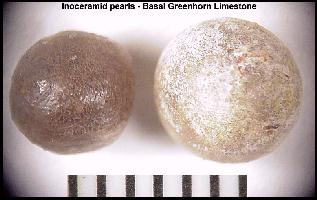 |
PEARLS FROM OTHER FORMATIONS
LEFT: Two small pearls (4-5 mm) from the base of the Lincoln Limestone Member
of the Greenhorn Limestone Formation (Upper Cenomanian) in Russell County, Kansas.
RIGHT: A cross section of the larger pearl shown at left showing. the
concentric layers. |
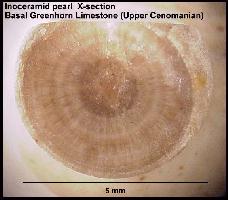 |
4. Borings: Many invertebrates that were living in the inland sea
are represented indirectly by casts, burrows and other evidence.
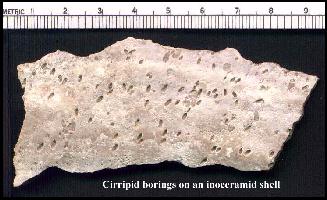 |
In some cases, the damage done
by cirripids as they bored into inoceramid shells is preserved while the actual animal is
not. In addition, the bottom muds of the inland sea may have been relatively low in oxygen
and may have not supported large numbers of smaller invertebrates. There is still much
work to be done in defining the somewhat limited invertebrate community of the inland sea.
|
5. Burrows - Burrow structures from worms and other invertebrates
were not generally preserved in the soft mud of the inland sea but can be found indirectly
in some chalk strata. Currently, it is believed that the harder layers of chalk are
evidence of thorough mixing (bioturbulation) by bottom dwelling organisms. It is likely
that much of the evidence was simply not preserved due to the consistency of the mud and
other, adverse chemical conditions as such lower levels of dissolved oxygen.
6. Bentonites - These are the remains of the ash (usually rust red
in color) from volcanic eruptions that fell on the surface of the ocean. There are more
than 200 bentonites in the Smoky Hill Chalk, each of which represents the eruption of a
fairly large volcano (larger than Mt. St. Helens in May of 1980) to the west of present
day Kansas. Some are an inch or more in thickness. Hattin (1982) used several of these
bentonites as part of his stratigraphic marker units in the chalk.
7. Iron concretions: Iron concretions are found through out the
Smoky Hill Chalk, but most often in the lower one-third. These concretions can form in
many shapes and sizes and are composed primarily of iron sulfide (jarosite). In some cases
they may form around bits of inoceramid shell or other debris. When freshly exposed, they
are often shiny and exhibit various metallic colors on the surface. They tend to degrade
fairly rapidly into splintery marcasite when exposed to moisture and often shatter or
become piles of rust-red debris.
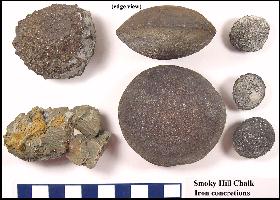 |
LEFT: The smaller, oval forms
are referred to as "pop-rocks" locally. They may be relatively smooth or
have a definitely rough, crystalline surface. Small cubical pyrite nodules are found at
some levels.
RIGHT: A large concretion formed on an inoceramid shell
fragment, and roughly shaped like an animal. |
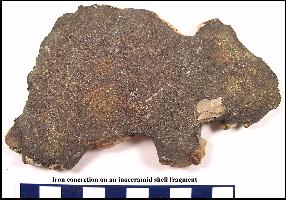 |
8. Silicified chalk - Variously referred to as Smoky Hill or Niobrara
jasper, silicified chalk was formed after eroded and exposed chalk was covered
by the sand of the Ogallala Formation. Silica leaching from the sand
permeated the chalk and hardened it.
"Smoky
Hill jasper, also known as Niobrara, Graham, or Republican River jasper,
is derived from the Smoky Hill Formation of the Central Plains. This formation
outcrops over a fairly widespread area across Kansas, Nebraska, Colorado, and
Wyoming, although the highest quality chert-bearing deposits are limited
primarily to locations from west-central Kansas to southwest Nebraska (see
Hattin 1982). Smoky Hill jasper is a highly siliceous material that varies in
color from caramel to dark brown, tan, black, white, green, yellow, and red.
These materials frequently occur as flat, tabular cobbles banded with several of
the above colors. Concentrations of quarries have been located in Graham, Trego,
and Gove counties in Kansas (see Banks 1990:96; Stein 1997)." Excerpt from
pages 183-184 of Brosowske, S.D. 2005. The evolution
of exchange in small-scale societies of the Southern High Plains. Unpublished
Ph.D. Dissertation, University of Oklahoma, 526 pp.
"Nodular, usually
stratiform masses of chert occur within the Smoky Hill Chalk at several places,
e.g., at Locality 23, at several places in Graham County (Prescott, 1955, p.
47), and at Norton (Logan, 1897a, p. 220). At locality 24, the nodules reach
thicknesses as great as 15 cm (0.5 ft). Smoky Hill chert is associated with
highly weathered chalk and occurs in the uppermost part of the exposure.
According to Frye and Leonard (1949, p. silicification took place at the same
time as the silicification in adjacent Ogallala (Miocene and Pliocene) beds."
Excerpted from Hattin, 1982, p. 19.
"In
a few places the chalk beds carry large amounts of chert which seem to be
interstratified with the chalk. This is well represented at Norton, along the
Prairie Dog Creek. Northwest of town about a mile the chert is quarried to a
considerable extent. Plate XXVIII shows this, and Plate XXIX shows the same
chert capping a chalk bluff at the old mill, Norton." Excerpted from Logan,
1897, p. 220-221, Volume II of the University Geological Survey of Kansas.
"From
the bluffs south of the Smoky a large quantity of clayey limestone has been
brought to fill the well. I found in these pieces of rock very good specimens of
common opal. They are white and look like porcelain, and were formed by the
infiltration of siliceous springs into the cretaceous strata; the magnesia
contained in the latter caused the silica to assume the opaline rather than the
agate or chalcedonic form." Excerpted from From
LeConte 1868, page 11.
For additional background information on Kansas geology, Smoky Hill Chalk,
marine fossils of the Late Cretaceous and paleontology in general, see my Late Cretaceous
Marine references about Marine reptiles and Fish and other fossils.
BACK TO INDEX



